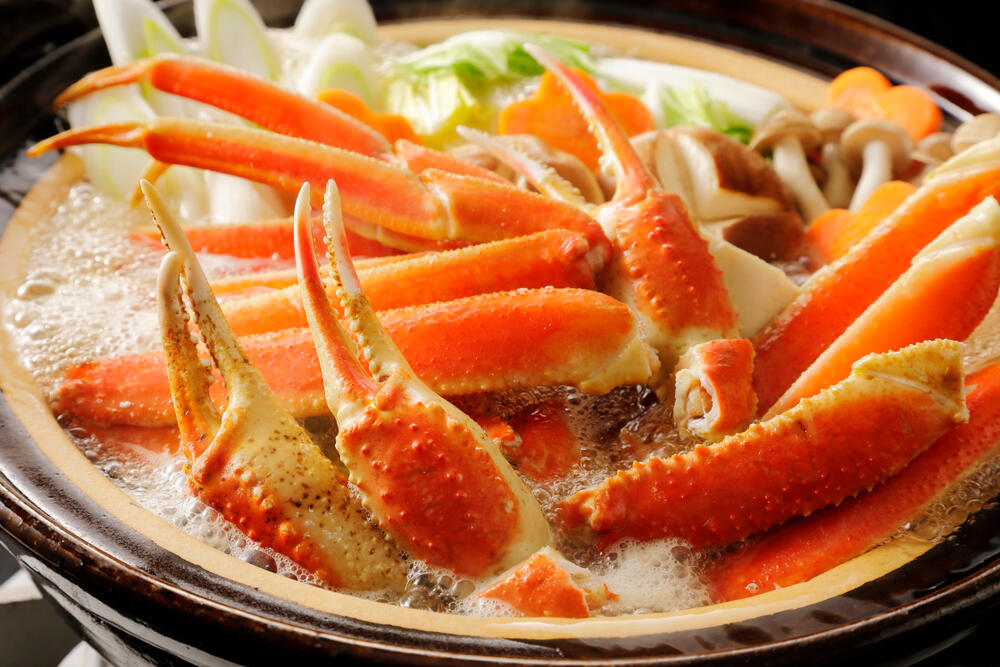Simmered in a hotpot, shredded on rice bowls or simply served whole - Japan’s crab dishes are a real treat for seafood lovers. There are three regions known for catching exceptional crabs, with a surprising amount of delicious varieties. While some can fetch prices in the millions of yen, crab can also be very affordable if you know what to look for.
Oct 27. 2023
6 Popular Types of Japanese Crab & Where to Eat them!

The Best Regions for Crab in Japan


There are three main areas known for crab in Japan: Hokkaido, Hokuriku and the San’in Regions. While many have heard of Hokkaido, the shores of San’in and Hokuriku are a little less well-known. The San'in region refers to the northern part of the Chugoku Mountains facing the Sea of Japan. Tottori and Shimane prefectures in particular are famous for their high quality crab production. The Hokuriku region is located on the west side of Japan, consisting of Fukui, Toyama, and Ishikawa prefectures. Along the Sea of Japan, calm, cold waters allow for the harvesting of luxury crabs such as Kano-gani from Ishikawa Prefecture and Echizen crab from Fukui Prefecture. Surrounded by the Sea of Okhotsk, the Pacific Ocean, and the Sea of Japan, Hokkaido is blessed with abundant marine resources. It is home to a variety of crustaceans, of which crabs are very popular as winter delicacies.
Red King Crab (タラバガニ, Tarabagani)


One of the most popular in Japan and nicknamed ‘King of Crabs’, Red King Crabs are the largest of the King Crab variety. They can grow to over one meter in length, making them exceptionally popular with fishermen. They are found in the cold waters of the Pacific Ocean - particularly the Sea of Okhotsk, hence they are often imported from Russia. However, during Japanese crab season they can also be caught in large quantaties near the fishing port of Wakkanai (稚内) on the northernmost point of Hokkaido. While the crabs are a dull brown when caught, they turn a fantastic red when cooked - lending them their name. The crabs are available from April to June and November to February.
Blue King Crab (アブラガニ, Aburagani)


With a shell width of about 20 cm, Blue King crabs are slightly smaller than their Red King counterparts and can be fished for longer periods, making them a more affordable option. Known for their blue colour when uncooked, they can be found in the Sea of Japan, the Bering Sea, and the Sea of Okhotsk. If served completely fresh, the taste can be just as delicious as Red King Crab, perfect for crab lovers who want to eat a lot.
Snow Crab (ズワイガニ, Zuwaigani)


The snow crab is smaller than the king crab, with even large males measuring about 70cm. It is mostly caught in the Sea of Japan and lives mainly in the deep sea at depths of 200m to 400m or more.
Snow crab is known for being succulent, creamy and tender. After eating the raw or boiled snow crab meat, it is recommended to use the innards to make zosui (rice porridge), simmered dishes, pasta, gratin, and other recipes. Called Zuwaigani (ズワイガニ) in Japanese, the males are also known as Matsuba-gani (松葉がに) if caught in Kyoto, Hyogo or Tottori, or Echizen-gani (越前がに) if caught in Fukui. Females are known as Seiko (セイコ) or Kobako (香箱), with their orange eggs making a popular topping for rice. Their season runs from November to March and they’re a popular winter dish across Japan.
Horsehair Crab (毛ガニ, Kegani)


Also known as the hairy crab, this smaller crab variety has an average weight of 400 to 600 grams, while the extra-large ones weigh 700 to 900 grams. Despite this, they are one of the most popular crabs in Japanese cuisine as they are affordable and tasty. They have a good amount of rich innards and crab meat, with shorter, fatter legs than larger varieties. The peeled shell is ideal for making a flavorful soup stock.
Hanasaki Crab (花咲ガニ, Hanasakigani)


Hanasaki crab is a rare crab that is also known as "phantom crab" because it is only caught in the town of Nemuro, Hokkaido, and some other areas in eastern Hokkaido. It is a member of the red king crab family, but its shell is small, measuring only 15cm. Named both after its growing red colour during cooking (hanasaki meaning ‘blooming flower’) as well as the port it is primarily caught in, the hanasaki crab is a Hokkaido specialty. The town of Nemuro (根室) has an annual festival to celebarte the start of the season with many forms of crab to try. This small species is popular for the eggs found in females as well as the sweet flavour of the crab meat.
Japanese Spider Crab (高足ガニ, Taka-ashi-gani)


Translating as "tall-legged-crab", spider crabs appear almost similar to creatures from science-fiction films. Reaching up to 4m in leg span, they are the largest species of crustacean. As they live in deep waters, they are not widely fished and are considered a delicacy in Japan. The largest catch of this type of crab is caught in Shizuoka Prefecture. The Toda area facing Suruga Bay is dotted with restaurants and specialty stores where you can try sashimi and boiled spider crab.
How to Enjoy Eating Crab In Japan


One of the most important elements of enjoying crab in Japan is knowing which species you will try, and which part is the most delicious. King crabs are characterized by their meaty, chewy, and succulent texture. Therefore, it is recommended to simply grill or boil king crab or to make crab shabu-shabu with vegetables and tofu. Boiled snow crab has a slightly sweet flavor, perfect for sashimi when fresh. Small, inexpensive hairy crabs are filled with delicious crabmeat, which is delicious eaten as is, but is also recommended for use in hot pots, pasta, gratin, and other dishes. Crabs also produce good soup stock from their shells, so even after you have finished eating the meat, be sure to use it again in nabe, zosui (rice porridge), miso soup, and other dishes.
Contents Source
This information is sourced by Fun Japan Communications Co., Ltd.
There may be business closures, changes to hours of operation,
or temporary suspension of the service of alcoholic beverages, etc.,
implemented without prior notice.
For details, please check the official websites or inquire with the
establishments directly.


